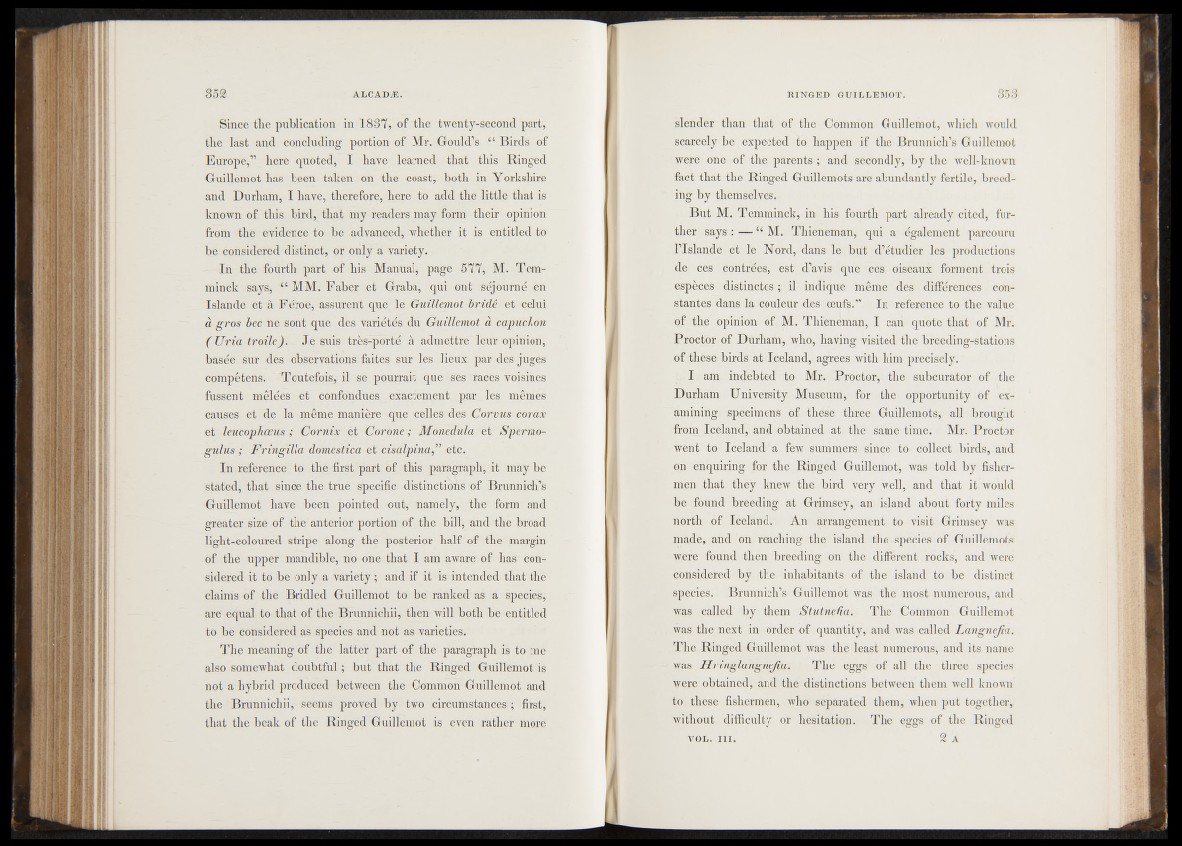
Since the publication in 1887, of the twenty-second part,
the last and concluding portion of Mr. Gould’s “ Birds of
Europe,” hero quoted, I have learned- that this Ringed
Guillemot has been taken, on the coast, both in Yorkshire
and Durham, I have, therefore, here to add the little that is
known of this bird, that my readers may form their opinion"
from the évidence to be advanced, whether it is entitled to
be considered distinct, or only a variety. .
—In the fourth part of his Manual, page- 577, M. Tem-
minck saySj “ MM. Faber »èé Graba, qui ont ,séÿourné-«en
Islande et à Féroë, asSurefit que le Guillemot bridé éklcëlui.
à gros bec ne sont que des variétés du Guillemot à capuchon
(Uria troile). Je suis trè'S^^pôrté à' 'admettrë'Hèur opinion'!
basée sur des ofrservationnJaites sur lesJieux- par des jugés
compêtens. Toutefois; itese pourrait que^Sg^îfaces voisines
fussent mêlées • et; confondues exactement . par les mèmès
causes et de la même manière que 4cëlles des Corvus corax
et leucophoeus ; Cornix .et Cor one ; Monèdula :èi Spefmo-
gulus ; Fringilla domestica et.cisalpina,” etc.
In .reference“to the first part öf this paragraphed may be
stated^ that since the true specific distinctions of Brunnich’s
Guiïïenrot have been-pointed out-,- n am ^ , _th^ form <fand
greater size of the anterior portion t.of the bill, and the broad
light-coloured stripe along thé- posterior half-of the* margin
of the upper mandible* no oné-that I ami aware of-ha#- considered
it to be only a variety ; and if it is intended that the
claims-of the Bridled Guillemot to be ranked- as a species;
are equal to that of the Brunnichii, then will both bê»entitled
to be considered as species and not as-.varieties.
The meaning of the latter part of the paragraph is to me
also somewhat doubtful ; but that the Ringed Guillemot is
not a hybrid produced between the Common Guillemot and
the Brunnichii, seems proved by : two circumstances ; first,
that the beak of the RingedTGuillemot is even rather more
slender than that, of the Common Guillemot, which would
scarcely b e , expected îÊé happen if the Brunnich’s Guillemot
were one ?of the parents ; and secondly, by the well-known
fact that the Ringed Guillemots are abundantly fertile, breeding
by theisêlves.-
But M. Temminck, in his fourth part already cited, further
says : — u M. Thienèmân, qui a également parcouru
.l’Islande-' et -lè\;Nórd, dans le> but d’étudier les productions
de ces jéontrèes, est ;d>âvis 4u'e ces oiseaux forment trois
|©spèceSv distinctes ; iKindique même des différences ccm-
stantes^aùs ia couleur des.'oeufs.” In ‘ reference to the value
of thé opinion of M. Thienèmân, I caii quote, that of Mr.
Proctor of Dürham, who, having visited the breeding-stations
of >Jhpsa birds at .Iceland, agrees with him precisely.
I am indebted ' to Mr. ^Proctor, the subcurator .of the
Durham University Mudfejun, for* the, opportunity of examining,
s^éciiüdné of these three Guillemots; all brought
feomjcelancf, and obtained at the same time. Mr. Proctor
wenUto Iceland'a few summers sinçe to collect birds, and
On ■ enquiring for- the Ringed Guillemot, was told by fishermen
-that they knew the bird very well, and that it would
b,-©. found breeding a,t Grimsey, an island about forty miles
north of Iceland: An arrangement to visit Grimsey was
made, and. on • reaching • the. island the species of Guillemots
were found then , breeding on theidifferent rocks, and were
considered the inhabitants of the island to be distinct
species. Brunnich’s Guillemot was the most numerous, and
was called by them Stutneûa. The Common Guillemot
was the next in order of quantity, and was called Langnefia.
The Ringed Guillemot was the least numerous, and its name
was Hringlangnefia. The eggs of all the three species
yete obtained, and the distinctions between them well known
to these fishermen, who separated them; when put together,
without difficulty or hesitation. The eggs of the Ringed
VOL. II I. i a